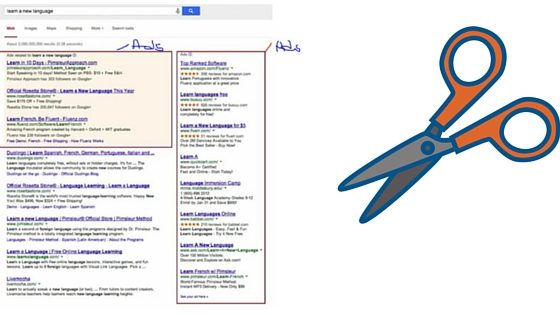The world of pay per click advertising has just witnessed a dramatic change to the display of ads on Google’s search engine result page. It is now clear, that Google has commenced the removal of ads from the right-hand side of desktop search results. This change came into effect on Friday 19th February.
Before the change
Before 19th February, three ads were displayed above organic search results for commercial queries (e.g. estate agent, SEO agency, blocked drain, cheap venues, affordable removal) that indicated a strong buying intent. In the past, some commercial queries generated three ads above the search result and an average of 7-8 ads on the right-hand panel. A search for ‘learn a new language’ is highly commercial hence it generated about eight results on the right hand side of the SERP (search engine result page).

After the change
Currently, Google only show ads at the top and bottom of SERP. The right-hand side panel will now be reserved for product listing ads and Google’s knowledge graph. A search for ‘learn a new language’ did not return any ads on the right-hand panel as a result of the new change.

Product listing ads will still appear at the right hand side panel. A search for ‘Pilate Mat’ retuned four ads above search results and eight product listing ads at the side panel. Google clarified that four search ads will be displayed above search results for “highly commercial queries.” This change has sent shivers down the spines of most PPC marketers as the number of ads that appear on the first page has reduced to about seven for highly commercial queries as opposed to over eleven before the changes were implemented.

An alignment between mobile and desktop search experience
The search engine result page on desktop is now similar to that of mobile. On mobile devices, there are ads above and below search results. One could imagine and guess that Google is aiming to create a similar search experience across all devices
The ultimate concern for most paid search marketers is the fear of bidding slightly higher to appear on the first page as the competition will be fierce. Also there is the fear that ads that appear below search results may fail to lead to conversions as compared to ads that appeared on the right-hand panel in the past.
PPC optimisation tips:
- A deeper keyword research: With the threat of having a fewer number of ads on the first page of Google’s search engine result page, paid search specialists will have to conduct deeper keyword research beyond the Google Keyword planner. Keywords with a great commercial potential but with less competition will require higher consideration.
- Using the Auction insight report: It is now essential to utilise Google’s auction insight report to gain a better understanding on the competition and the position of their Ads. This will aid search marketers to bid more intelligently.
- Utilising Google’s draft and experiments: About a week ago Google made an announcement that search marketers can make test changes to an existing account without interfering with these campaigns. This feature will come very handy in an era where there are fewer paid slots on the SERP. With drafts and experiments, traffic can be split between an existing campaign and a test campaign to ascertain if a proposed change will enhance the performance of a campaign.
- More analysis from the top Vs other feature: The top Vs other feature helps paid search marketers and businesses understand the performance of ads that appear above the search results and those that appear by the side or below search results. It is now very important for paid search marketers to study the cost per click, cost per conversion and conversion rates of ads that appear above and below search results. This data will be instrumental to an effective optimisation of campaigns.
- The use of relevant ad extensions and customisers: The competition is now very fierce due to Google’s recent changes. Quality score will become a big factor in deciding the cost per click and positioning of advertisers on Google’s search result page. Ad extensions comprise of site links, call outs, structured snippet, review, location and call extensions. In addition, ad customisers can be useful in creating a more personalised search experience for users via an updated feed. Ad extensions and ad customisers will help to improve the click through rate which will enhance the quality score and reduce the cost per click.
The world of pay per click advertising is startled with this change from Google. Nonetheless, these tips are a few ways search marketers can make the most of the new paid search engine result page.
